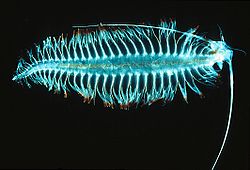| Phyllodocida Temporal range: | |
|---|---|
 | |
| The planktonic polychaete Tomopteris | |
| Scientific classification | |
| Kingdom: | Animalia |
| Phylum: | Annelida |
| Clade: | Pleistoannelida |
| Subclass: | Errantia |
| Clade: | Aciculata |
| Order: | Phyllodocida |
| Suborders | |
Phyllodocida is an order of polychaete worms in the subclass Errantia. [1] These worms are mostly marine, though some are found in brackish water. Most are active benthic creatures, moving over the surface or burrowing in sediments, or living in cracks and crevices in bedrock. A few construct tubes in which they live and some are pelagic, swimming through the water column. There are estimated to be more than 4,600 accepted species in the order. [2]